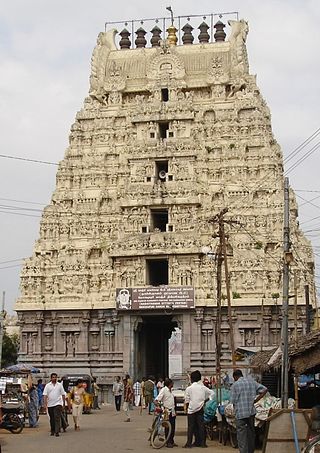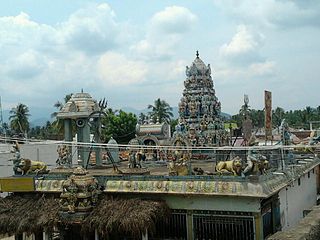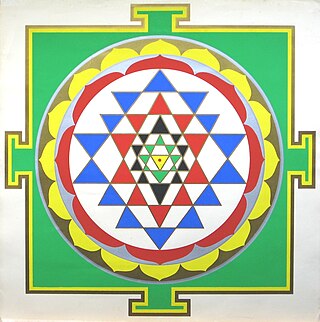
Puja is a worship ritual performed by Hindus to offer devotional homage and prayer to one or more deities, to host and honour a guest, or to spiritually celebrate an event. It may honour or celebrate the presence of special guests, or their memories after they die. The word pūjā is Sanskrit, and means reverence, honor, homage, adoration and worship. Puja, the loving offering of light, flowers, and water or food to the divine, is the essential ritual of Hinduism. For the worshipper, the divine is visible in the image, and the divinity sees the worshipper. The interaction between human and deity, between human and guru, is called darshan, seeing.

In the Hindu tradition, a murti is a devotional image, such as a statue or icon, of a deity or saint used during puja and/or in other customary forms of actively expressing devotion or reverence - whether at Hindu temples or shrines. A mūrti is a symbolic icon representing Divinity for the purpose of devotional activities. Thus, not all icons of gods and saints are mūrti; for example, purely decorative depictions of Divine figures often adorn Hindu temple architecture in intricately carved doorframes, on colourfully painted walls, and ornately sculpted rooftop domes. A mūrti itself is not God, but it is merely a representative shape, symbolic embodiment, or iconic manifestation of God.

The Sri Mariamman Temple is Singapore's oldest Hindu temple. It is an agamic temple, built in the Dravidian style. Located at 244 South Bridge Road, in the downtown Chinatown district, the temple serves the majority Hindu Singaporeans, Tamilians, in the city-state. Due to its architectural and historical significance, the temple has been gazetted a National Monument and is a major tourist attraction. Sri Mariamman Temple is managed by the Hindu Endowments Board, a statutory board under the Ministry of Community Development, Youth and Sports.

Tripura Sundari, also known as Rajarajeshvari, Shodashi, Kamakshi, and Lalita, is a Hindu goddess, revered primarily within the Shaktism tradition and recognized as one of the ten Mahavidyas. She embodies the essence of the supreme goddess Mahadevi. Central to the Shakta texts, she is widely praised in the Lalita Sahasranama and Saundarya Lahari. In the Lalitopakhyana of the Brahmanda Purana, she is referred to as Adi Parashakti.
Thiruppathisaram is a village in the Kanyakumari District of Tamil Nadu, the southern Indian state. This village is renowned for the Thiruvazhmarban Temple dedicated to Lord Thiruvazhimarban, Supreme God (Vishnu).
Prana pratishtha is the rite or ceremony by which a murti is consecrated in a Hindu temple, wherein hymns and mantra are recited to invite the deity to be resident guest, and the murti's eye is opened for the first time. Practised in the temples of Hinduism and Jainism, the ritual is considered to infuse life into the Hindu temple, and bring to it the numinous presence of divinity and spirituality.

The Kamakshi Amman Temple, also known as Kamakoti Nayaki Kovil, is a Hindu temple dedicated to the goddess Kamakshi, one of the highest aspects of Adi Parashakti, the supreme goddess in Shaktism. The temple is located in the historic city of Kanchipuram, near Chennai, India.

Ulipuram is a village in Gangavalli taluk, Salem district, Tamil Nadu state in India,.

Yantra (यन्त्र) is a geometrical diagram, mainly from the Tantric traditions of the Indian religions. Yantras are used for the worship of deities in temples or at home; as an aid in meditation; used for the benefits given by their supposed occult powers based on Hindu astrology and tantric texts. They are also used for adornment of temple floors, due mainly to their aesthetic and symmetric qualities. Specific yantras are traditionally associated with specific deities and/or certain types of energies used for accomplishment of certain tasks, vows, that may be materialistic or spiritual in nature. It becomes a prime tool in certain sadhanas performed by the sadhaka the spiritual seeker. Yantras hold great importance in Hinduism, Jainism, and Buddhism.

The Arulmigu Sri Mahamariamman Temple is a Hindu temple within George Town in the Malaysian state of Penang. The oldest Hindu temple in the state, it was built in 1833, and features sculptures of gods and goddesses over its main entrance and facade.
Yantra tattooing or Sak Yant is a form of tattooing using Indian yantra designs. It consists of sacred geometrical, animal and deity designs accompanied by Pali phrases that are said to offer power, protection, fortune, charisma and other benefits for the bearer.

Abhisheka is a religious rite or method of prayer in which a devotee pours a liquid offering on an image or murti of a deity. This is common to religions such as Hinduism, Buddhism and Jainism.

Pavitrotsavam is an annual ritual in the Tirumala Venkateswara Temple, Andhra Pradesh. Pavitrotsava is derived from the combination of two words Pavitra (holy) and utsava (festival). This utsava is penitential as well as propitiatory and its main objective is to get rid of the evil that might have been caused due to omissions and commissions in the performance of various rituals throughout the year. The festival is also known as Dosha Nivaarana ,Sarva Yajna Phalapradha ,Sarva Doshopasamana, Sarva Tushtikara, Sarvakaamapradha, Sarvalokasantida.

Tamil mythology refers to the folklore and traditions that are a part of the wider Dravidian pantheon, originating from the Tamil people. This body of mythology is a fusion of elements from Dravidian culture and the parent Indus Valley culture, both of which have been syncretised with mainstream Hinduism.

Devipuram is a Hindu temple complex located near Visakhapatnam, Andhra Pradesh, India. Belonging primarily to the Shakta school of Hinduism, it is dedicated to the goddess Sahasrakshi, and her consort Kameshwara.
Thantri or Tantri is the Vedic head who stands in a top room in religion of Hindu. Thantri is person who set rule in temples, they are the authority in the temples of Kerala and temples in coastal Karnataka in southern India. It is a position held hereditarily. It is the thantri who installs the murti of the deity called prana pratishtha, and from that moment he assumes the position of the guru of the deity. The thantri is the authority on the rites and rituals of the temple.

Chettikulangara Sree Bhagavathi temple is one of the most renowned Hindu temples in Kerala. Main deity is Sree Bhadrakali. The temple is located at Chettikulangara in Mavelikkara taluk of Alappuzha district in the Indian state of Kerala. The temple is situated about 4 kilometres (2.5 mi) west of Mavelikkara town, 7 kilometres (4.3 mi) north of Kayamkulam city on SH6. Bhadrakali, is an incarnation of supreme mother Shakthi devi, born from the third eye of Lord Shiva, to kill the demon king Daruka. 'Bhadra' means good and 'Kali' means goddess of time. So Bhadrakali is worshipped for prosperity and salvation. Devi is considered as the creator, protector, destructor, nature, power and Kundalini shakthi. Chettikulangara is located near Kayamkulam city.

The Ambubachi Mela is an annual Hindu mela (gathering) held at Kamakhya Temple in Guwahati, Assam. This yearly mela is celebrated during the monsoon season that happens to fall during the Assamese month Ahaar, around the middle of June when the sun transits to the zodiac of Mithuna, when the Brahmaputra river is in spate. During this time Brahmaputra River near the temple turns Red for three days.

Tirunageswaram Naganathar Temple also known as Rahu Stalam is a Hindu temple dedicated to the deity Shiva, located in Tirunageswaram, a village in the outskirts of Kumbakonam, a town in Tamil Nadu, India. It is significant to the Hindu sect of Saivism as one of the temples associated with the nine planet elements, the Navagraha Stalas, and specifically Rahu. Shiva is worshiped as Naganathar, and is represented by the lingam. His consort Parvati is depicted as Piraisoodi Amman. The presiding deity is revered in the 7th-century Tamil Saiva canonical work, the Tevaram, written by Tamil saint poets known as the nayanars and classified as Paadal Petra Sthalam.

Over the millennia of its development, Hinduism has adopted several iconic symbols, forming part of Hindu iconography, that are imbued with spiritual meaning based on either the scriptures or cultural traditions. The exact significance accorded to any of the icons varies with region, period and denomination of the followers. Over time some of the symbols, for instance the Swastika has come to have wider association while others like Om are recognized as unique representations of Hinduism. Other aspects of Hindu iconography are covered by the terms murti, for icons and mudra for gestures and positions of the hands and body.

















